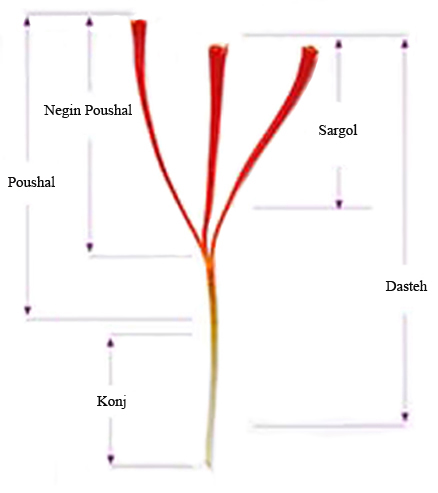 Iranian Saffron Types, Similarities and Differences
Iranian Saffron Types, Similarities and DifferencesThere are different saffron types in the market with different prices. Various Iranian companies supply saffron in different types especially in three categories include Sargol (All-Red saffron), Poushal and Dasteh. This classification is based on the fact that which part of saffron strands is exist in the final product. So, our purpose in expression “saffron types” is not related to companies or production places. But, it is related to red and white part of saffron strands in the product.
Saffron classification in Iran, includes three main types and other types usually are special cases of these types.
Before anything you should know that expressions “stigma” and “style” are related to red and white part of saffron strand respectively.
Dasteh saffron is the main and basic saffron types and is achieved by putting all part of saffron strands over each other and drying them. Normally length of style is about 3 to 5 mm and the stigma can be shorter or longer which determines the product quality. Embedding strands over each other can be one-way or two-way. In one-way embedding, similar parts should be on each other (style on the style and stigma on the stigma). In two-way embedding, styles should be on the middle and stigma on both sides. The second form is more attractive because only red parts (stigma) will be seen in both sides. Classification of saffron strands usually is done by women.
The right part of the image on the top of the page is the “Dasteh” saffron. Dasteh saffron is saffron strands grade 4. Overall color of this saffron type is between 120 to n150 units.
“Poushal” Saffron consist of red stigma with 1 to 3 mm of yellow style. In comparison with the “Dasteh”, “Poushal” has more relative content of stigma. So Poushal saffron has more overall color which is between 170 to 250 units based on its quality. Attaching stigma to the style and reducing the likelihood of counterfeit, causes some people have more trust to this type of saffron.
Saffron strands grade 1, 2 and 3 are Poushal types.
Sargol saffron in fact is the saffron concept on the mind of most of people. In this type, style is removed completely and separated red stigma form pure saffron. So, Sargol is all-red type saffron. In some cases, “Poushal” also is known as “Sargol”. In this case saffron is divided into two types of “Negin Sargol” and “Momtaz Sargol”. Negin is refer to excellent and Momtaz is refer to prefer types. Negin Sargol is the same as mentioned Sargol saffron and the Momtaz contains some part of yellow style.
Among the above mentioned saffron types, overall color of Sargol saffron is more than others and is between 210 to 260 units. Us of Sargol saffron is more conventional than the others in Iran.
Different saffron types can be seen in the following picture.
 “Negin Poushal” or “Poushal Negin” Saffron
“Negin Poushal” or “Poushal Negin” Saffron“Negin Poushal” saffron is actually a special type of Poushal in which thick strands of red stigma is separated from other strands without any style and bulky saffron is produced. “Poushal Negin” saffron is finest and most precious type of saffron and has highest overall color (230 to 270 units). Production of this saffron type has descending trends among different years because of its costly and time consuming procedure. In some cases this type of saffron is called “Super Negin”.
After removing “Sargol” from “Dasteh”, the root part of strands remain. This part is known as “konj” or “Sefid” Saffron in Iran. “Konj” is known as style or white in Europe. “Konj” is not a kind of saffron types but is considered due to its beautiful color and appearance. Some people incorrectly think that “konj” is more perfumed than the Sargol. Scientific studies show that valuable elements of saffron are only in its red stigma. These elements can transfer from stigma to the style due to move in plant tissue. More moisture in the style causes more aroma apparently.
The email newsletter can auction and special promotions in every moment of our products to be notified.